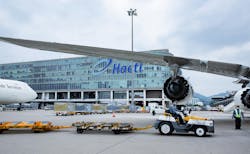Ground Support’s Progress with Sustainability Goals
Sustainability is increasingly defining the aircraft ground handling industry and ground handling companies are implementing a variety of initiatives thanks to technology and investment.
As the commercial aviation industry continues to strive for a greener industry, sustainability efforts will continue to be developed.
Vision
The vision of ITW GSE is to supply the aviation industry with clean, reliable, and cost-efficient GSE systems and provide sustainable and innovative solutions.
“The rise in demand for greener GSE solutions reflects the industry’s commitment to environmental responsibility,” says Steven Ng, sales director at ITW GSE Asia Pacific. “We anticipate that ongoing advancements in electric vehicles and battery technology will contribute to ever more efficient batteries, and – drawing a parallel with the automobile industry – economies of scale can drive the development of new energy storage technologies, which leads to more adoption of the electric ground power unit (eGPU) in the near future.”
An important sustainability initiative of dnata has involved implementing global waste reduction strategies, as the company minimizes single-use plastics and recycles materials wherever possible in all operations.
“Our latest initiative focuses on recycling plastic sheets used in the movement of goods – a crucial step in reducing plastic waste and promoting responsible resource management,” says Charles Galloway, dnata’s regional CEO, airport operations – Asia Pacific.
Innovation
Innovation is another key enabler, according to Tan Yen Ling, head of group sustainability at SATS. “Our joint venture, AISATS, has made strides in this respect with the introduction of solar-powered boarding ramps and GPUs, as well as AeroWash service for aircraft. The latter is a robotic dry wash service which saves 350 liters of water per wash (for narrow-body aircraft) compared to manual methods,” she explains. “It uses a 100 percent plant-based biodegradable cleaner with zero volatile organic compounds (VOC) and poses zero health hazards to our staff.”
SATS has taken the step of joining the IATA Environmental Assessment Program (IEnvA).
“The IEnvA provides a consistent standard for improving environmental management in the aviation industry and aims to encourage continual improvements in performance through embedding environmental sustainability management in day-to- day operations and decision-making,” Tan says. “The program provides a framework for achieving environmental sustainability across all ground operations, such as cargo handling, apron and passenger services.”
Driving Factor
Indeed, sustainability has become a prominent driving factor in ground handling exploration to more sustainable and efficient operations, affirms Mohamad Khairi Ngadiran of the project management office of Malaysia’s AeroDarat.
“We have developed multiple initiatives to undertake a sustainability path, one of these through a management program, where we put Euro 5 and Euro 6 engine technology as part of requirement in procuring any ground support equipment,” he says. “We also take waste management seriously as it is our responsibility to comply with local regulations on the appropriate management of ground handling waste. As to the fuel efficiency for our equipment, we already adopted the use of biodiesel, a low-level biofuel blend consisting of petroleum diesel and up to 7 percent bio-based diesel for all the Malaysia Aviation Group (MAG) fleet.”
According to Wilson Kwong, chief executive of Hong Kong Air Cargo Terminals Limited (Hactl), electric power is obviously a big potential area for smaller GSE such as tugs for dollies, and smaller loaders.
“Hower, currently the use of electrical power for much larger equipment is not as developed and needs to mature, before it offers the capability and reliability operators like ourselves need for the top end of the cargo handling market,” he says. “It is also possible that manufacturers may see the benefits of alternative power sources such as hydrogen fuel cells, or internal combustion engine (ICE) power using hydrogen as fuel. The latter is being developed and trialled for heavy construction plant and heavy goods vehicles, which share some of the characteristics of heavy GSE such as large aircraft tugs and main deck loaders.”
Infrastructural Development
Infrastructural development is a key enabler of vehicle electrification, according to Tan.
“Operating in an airport environment, the ability to scale SATS’s electrification plan is dependent on the availability of airside charging infrastructure that is fit-for-use beyond tractors to include other types of vehicles of different dimensions and power needs,” she says. “Apart from vehicles, SATS has also undertaken a range of initiatives to manage our Scope 2 emissions. Within the buildings we operate such as the airfreight terminals, we have introduced solar panels, replaced less efficient fluorescent lighting with LEDs and introduced smart metering.”
dnata is constantly evaluating its processes, technology and practices to identify new ways to enhance sustainability, affirms Galloway.
“Every small change makes a big impact, and for this, over the past year, we have installed a 3.5 megawatt-peak rooftop solar power system at our catering and cargo buildings at Singapore Changi Airport. Most recently, our Singapore facilities have benefitted from the installation of Cooling as a Service technology, providing chilled water and air conditioning, saving at least 650 metric tonnes of carbon and 1.5 million kilowatt hours of electricity per year,” he says. “This has resulted in a 54 percent annual reduction in energy consumption at our cargo base, and a 35 percent reduction at our catering and support offices.”
Airport bodies could play a bigger part in driving sustainable ground handling, using their neutrality to encourage actions on a community basis – as Hong Kong has done, observes Kwong.
“But this needs to be done in a light-touch manner, as GSE is a major investment that is amortized over long periods, and so cannot (and indeed should not, for sound environmental reasons) just be scrapped prematurely to make way for newer technology that appears to offer a short-term carbon reduction benefit,” he concludes.
About the Author

Mario Pierobon
Dr. Mario Pierobon provides solutions in the areas of documentation, training and consulting to organizations operating in safety-sensitive industries. He has conducted a doctoral research project investigating aircraft ground handling safety. He may be reached at [email protected].
